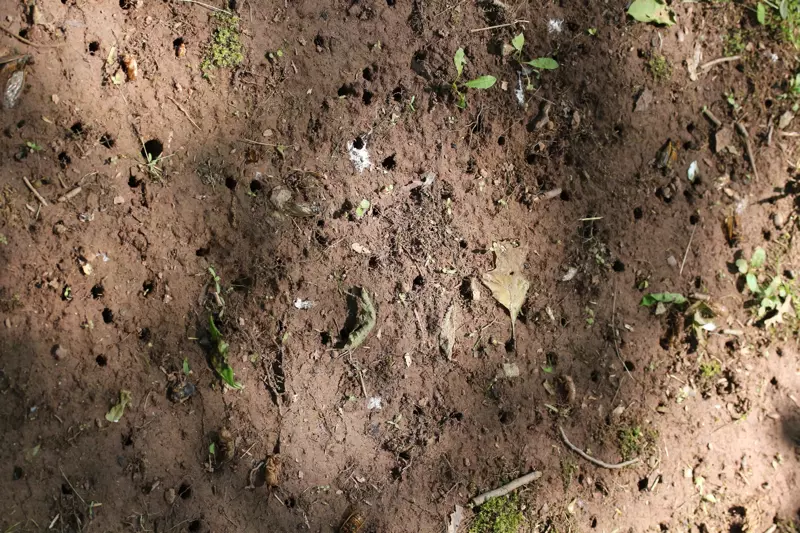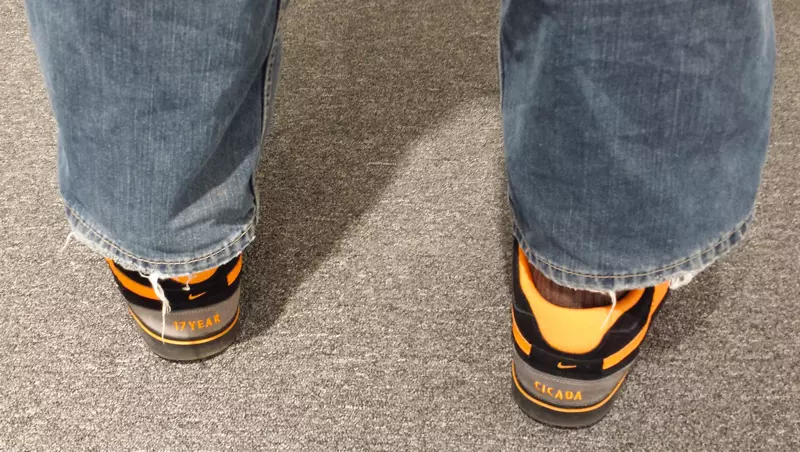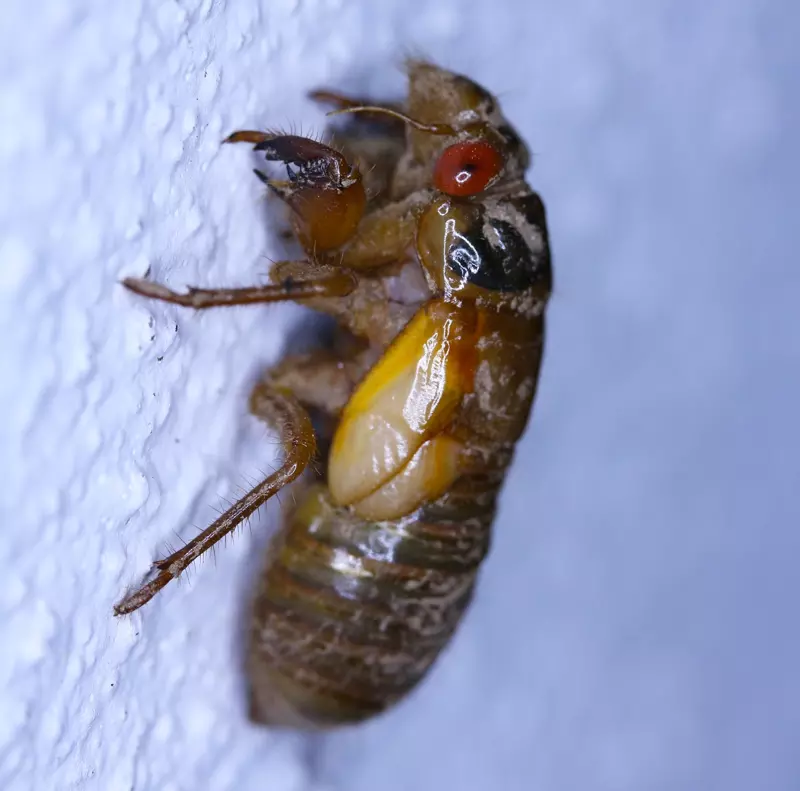A news story came out in November reporting that M. cassini appeared in areas of Connecticut where they were not expected during the Brood II emergence this year. This must have been a 2013 highlight for cicada researchers in the Connecticut area.
Category: Broods
Magicicada periodical cicada Broods.
 I am excited about the 17 and 13 year cicada emergences expected in 2014.
I am excited about the 17 and 13 year cicada emergences expected in 2014.
Here is what we can look forward to:
- Brood XXII, the Baton Rouge brood. This brood of 13 year Magicicada will emerge in Louisiana and Mississippi. When they emerge depends on the weather, but probably April to May.
- Brood III, The Iowan Brood. This brood of 17 year Magicicada will emerge in Iowa, Illinois and Missouri. This emergence will likely peak in June, depending on the weather.
- A 13 Year cicada emergence in Ohio and Kentucky. This group of 13 Year Magicicada hasn’t officially been associated with a brood. May-June is my guess.
- Stragglers from Broods II, IV, XXIII, and VII might emerge next year (see our brood chart for locations). The best bet will be Brood VII stragglers. Brood VII is located in upstate NY (June).
I’m looking forward to taking some vacation time and tracking cicadas. Brood XXII is a good excuse to visit New Orleans (even if it isn’t on the cicada map).
Fun fact: Brood III and XXII won’t emerge in the same year again until the year 2235.
2013 has been an awesome year for cicadas. Here’s a look back at my favorite Brood II moments.
- My 17 Year Cicada sneakers:

- The They’re Baaack! Return of the 17-year Cicadas exhibit at The Staten Island Museum.
- Meeting Ed Johnson of the Staten Island Museum.
- Being interviewed by and appearing in Wired Magazine.
- This April Fools Day joke (that no one believed).
- Hipster Cicada

- Cicada Ron Swanson

- Keep Calm, They’re only 17 Year Cicadas

- Getting 7,500 visits from Reddit in a single day (April 7th).
- Finding the first nymph on April 16th under a garden slate, not ready to emerge.
- Finding the first cicada chimneys on May 10th.
- Giving a presentation about cicadas at musician/naturalist/philosopher/professor David Rothenberg’s “Richard Robinson: Song of the Cicada (World Premiere), Insect Music, based on the calls, chirps and clicks of various insects” event in New York City.
- Finding and photographing Magicicada septendecula, thanks to Elias Bonaro’s keen hearing.
- My sister’s chihuahua discovering a cicada nymph.

- Cicada tracking in New York state.
- An interview with Sonja Beeker of the German radio program Neonlicht.
- The Oklahoma Brood II emergence. A lot of us didn’t expect it, but Oklahoma residents did. Add another state to the Brood II map!
- Shooting lots of cicada video for the site
- Observing the Magicicada cassini’s “musical chairs” calling and flying routine, captured in this photo by Roy Troutman.
- Having Roy and Michelle Troutman visit New Jersey (I think Michelle enjoyed the beach more than the cicadas).
- Going cicada hunting with Roy Troutman and Elias Bonaros

- The Joy of Six Legged Sex event at the Staten Island Museum, featuring John Cooley and Ed Johnson. Roy, Michelle, Elias and David Rothenberg were also in attendance.
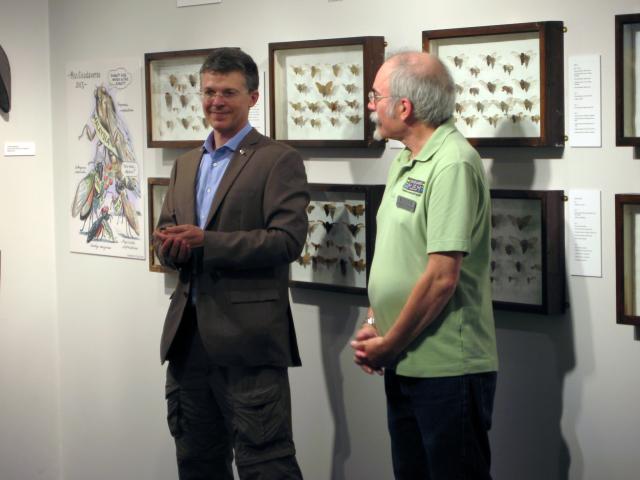
- Going cicada hunting in Staten Island with Elias and Chris Simon.
- Going cicada hunting with John Cooley, David Rothenberg, and a crew from the New York Times, and ending up at my folk’s place in Metuchen.
- Fighting back against companies that sell pesticide to kill cicadas.
- Discovering that the periodical cicadas along the shore of Staten Island survived Superstorm Sandy.
- Meeting cicada filmmaker Sam Orr.
- All the reports, comments, Tweets, and cicada photos sent to us by Cicada Mania readers. You make it all worthwhile.
- The Finneytown, Ohio acceleration… technically not Brood II, but…
- All the cool cicada community science opportunities presented by magicicada.org, the Simon Lab, the Urban Buzz Project, Gene Kritsky and Radiolab.
I’m looking forward to the Brood III and XXII emergences next year, but I don’t know if they’ll be as fun as Brood II 2013.

Where’s the cicadas?
At this point in the 2013 Brood II emergence, all the cicadas that will emerge, have emerged. I’m sorry to say that if periodical cicadas have not emerged in your yard/neighborhood/town, they won’t. This is frustrating for people who heard that the cicadas would emerge in their state or those who looked at a brood map and assumed their neighborhood fell within the area shown on the map.
People in Pennsylvania, for example, heard that cicadas would arrive in their state, but unfortunately, the cicadas only occupy a small banana-shaped region in the east of the state:

If you look at one of the older maps for Brood II, it looks like the state of New Jersey is covered, however, each dot might represent only one sighing in one specific area. These old maps are useful, but they can be misleading (more on maps later in this article).

Back in 2004, after Brood X emerged, I wrote an article called: What Happened: the Magicicada No-Show of 2004. The information in that article is relevant for Brood II as well.
The truth is periodical cicadas do not occupy every square acre of a state in which they are expected to emerge. Even in towns where they do emerge, they are rarely present in every acre or block of those towns. Why? Well, either they were eliminated in the areas where they once were found (due to urban sprawl, pesticides, weather-related events, etc), or they simply were never there in the first place. New threats like extreme weather (flooding and tree destruction by tropical storms) and tree-destroying invasive species (like the emerald ash borer) will continue to shrink cicada habitat areas.
It is important, for future emergences, that the press/media and cicada websites provide more accurate information about the location of the cicadas. The cicada sighting information people provide to Cicadas @ UCONN (formerly Magicicada.org) is very important because it will lead to better maps and more accurate sighting information.
One thing I’m glad that I did this year was to provide a page that listed specific towns in New Jersey where cicadas could be expected. I wish I did one for every state in the Brood II area [but Cicada Mania is not my day job, and there are only so many hours in a day].
That said, we never want to discourage people from looking for periodical cicadas in areas we don’t expect them to exist. Last year unexpected Brood I cicadas emerged in Tennessee. This year periodical cicadas unexpectedly emerged in Oklahoma. A lot of us were hoping cicadas would show up in Central Park in Manhattan, but they didn’t (however, I didn’t personally walk every acre of the park).
So, what can you do to help?
- If you’re a member of the press/media (yes that includes bloggers and tweeters), make sure you get precise locations from cicada experts.
- Report cicada and flagging sightings to Cicadas @ UCONN (formerly Magicicada.org) so we have better records of the emergence.
- Help cicada research by participating in a cicada community science project.
- Help preserve the current cicada habitat. Preserve trees. Avoid pesticides. Don’t wipe out another forest to add yet another redundant giant store.
A consolation for people who missed out on the 17 year cicadas: there are about 160 species of annual cicadas in North America. They’re usually harder to find and catch, but you can still hear and capture them if you put some time and effort into it.
June 28th Update
At this point if you haven’t had a periodical cicada emerge in your yard/neighborhood/town, you won’t. The best last chance to see them would be in New York State along rte 9G, parts of 9 and 9J. The more northern, the better. I visited that area last weekend, and found some great spots.
Flagging (when leaves turn brown from cicada egg laying) can be seen in New Jersey and states south of there. Probably a little bit of Connecticut and New York as well.
People are noticing sap dripping from the scars left behind from cicada egg laying.
Next up will be the hatching of the eggs.
Don’t forget to report FLAGGING (brown leaves) sightings to Cicadas @ UCONN (formerly Magicicada.org) so they can add them to their live map. You can report flagging, as well as egg nests, and newly hatched nymphs.
As usual Cicada Mania offers a full line of shirts, glassware, buttons and other souvenirs:
June 17th Update
After visiting central New Jersey and Staten Island over the weekend it’s clear that the emergence in that area is past peak. There is less singing, plenty of ovipositing and some flagging.
Staten Island: Wolfe’s Pond Park and areas along Amboy Road still has enough cicadas to enjoy them, in Staten Island. Bloomingdale Park and High Rock Park are disappointing.
New York State along the Hudson River valley is the place to go to see them at their best. Places like High Falls & Germany Town, and as far north as Stuyvesant.
Rain spoiled a lot of the emergence (for cicada fans). Here is a funny editorial cartoon about the cicadas and frequent rain.
Enjoy some periodical cicada video I uploaded this weekend.
Some new sounds as well.
June 9th Update
We’re at the halfway point.
The 2013 Brood II emergence began somewhere between April, 23rd and May, 1st, in North Carolina and Virginia. Nymphs are still emerging along the Hudson River in NY and in Connecticut.
Here’s a nice gallery of images from Dani Siddle taken in the Malden-on-Hudson area.
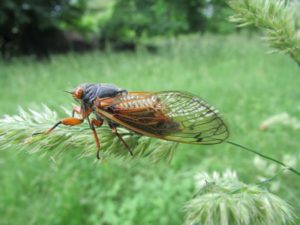
Areas in southern states are no doubt in the clean up phase. Adults have stopped singing, and corpses litter the ground, while the eggs of the next generation are nestled in branches high up in trees.
This is what to expect here on out:
They stink — literally, not figuratively. Yeah, their rotting corpses stink, so you want to clean them up. A rake and shovel work. Some people use vacuums, which are effective, but your vacuums might inherit the smell of the cicadas.
The hatch — in about 6-8 weeks the eggs laid in tree branches will hatch and the 1st instar nymphs will fall to the ground (see “THE ECOLOGY, BEHAVIOR AND EVOLUTION OF PERIODICAL CICADAS” by Kathy S. Williams and Chris Simon). The fall doesn’t hurt them because they have a low terminal velocity. Wear a hat in August. At this point they quickly dig into the soil, and start feeding on roots — small grass roots at first, and larger roots as they get larger. Chances are you won’t even notice them. Sadly, about 98% of them die in the first two years. Just imagine if they all survived — 5000% more cicadas!
The birds will come back — birds and other critters often leave a neighborhood during a cicada emergence. Either they get their fill of eating the cicadas, they can’t hear each other over the over-powering call of the cicadas, or they find it hard to navigate the sky and trees with all the cicadas around. What ever the case, birds and other animals will return to your neighborhood once the cicadas die off. Do not worry.
June 7th Update
Some interesting news stories:
Westfield Residents Learn the Good, the Bad and the Ugly of Cicadas
A podcast with David Rothenberg and John Cooley.
An Invasion of 17-Year-Olds, Loud, Lusty and Six-Legged
June 6th Update
It’s been nearly 2 weeks since my last update, but I’ve been busy — traveling around looking and listening for cicadas. I have literally 100s of photos and videos, and information to update the site with. Lots of info to come.
Ladies: check out these cicada-themed finger nails!
Road-tripers: East Coast Cicadas: (Road Side) Attractions They Couldn’t See In 1996.
Status of the emergence:
– Cicadas in North Carolina, Virginia and Maryland should be post-peak. Singing, mating, laying eggs, but mostly dying. New Jersey is at it’s peak — mostly singing, mating and laying eggs. Pensy, Staten Island and the rest of New York have cicadas in all phases, but they should still have some emerging nymphs to check out. If you want to watch nymphs emerging at this point, Connecticut is the place to go.
Locations I’ve visited and heard or saw cicadas:
New Jersey: Metuchen, Edison, Iselin, Colonia, Woodbridge, Westfield, Fanwood, Summit, Scotch Plains, Clark, Watchung…
Staten Island: most parks in southern SI, like Wolfe’s Pong Park (the cicadas survived Sandy) and Bloomingdale Park. Lots along Drumgoole road.
Locations other people reported:
– Meriden, CT
– Berkeley Heights NJ
– Flat Rock Brood Nature Center www.flatrockbrook.org in NJ
– Lewis Morris Park, Convent Station, Madison and Morris Township in NJ
– Maplewood in Essex County, NJ
– Millburn, NJ (South Mountain Reservation)
– Mountainside, NJ
– Plainfield, NJ
– Upper Montclair, NJ
– West Milford, NJ
– Cornwall-On Hudson, NY
– Red Hook, NY
– Glen Allen, VA
– Manassas Battlefield Park in VA
– Woodbridge VA
See the live map for the lastest 500 locations reported to Magiciada.org.
Where they’re not (sorry):
– DC (they’re south west of DC).
– Most counties in New Jersey south of Middlesex (with some exceptions).
– Most of Pensy
May 24th Update
Cold days ahead until Tuesday for the Brood II cicadas, at least in the northern states. Temperatures below 57 F/14 C will put the insects into a state of torpor, making them easy prey for critters. The rain and wind doesn’t help either. Read: “Adaptation of the Thermal Responses of Insects” by James E. Heath; James L. Hanegan; Peter J. Wilkin; Maxine Shoemaker Heath.
Some positive news: Cicadas @ UCONN has declared a pocket of Brood II in Georgia. Time to update the brood charts!
May 23rd Update

I heard chorusing for the first time in Metuchen, NJ today.
+ Berkeley Heights, NJ (thx Lucinda)
+ Finneytown Ohio (thx Roy) (technically not Brood II)
A video of a cicada undergoing ecdysis (emerging from its nymphal skin (exuvia)), from Rachel in Charlottesville, Va:
A video of The New Jersey Cicada Takeover in Summit NJ from Jason:
Here’s an adult cicada in Westfield NJ:
@cicadamania cicadas in Westfield, New Jersey twitter.com/DryopoidDarlin…
— Crystal Maier (@DryopoidDarling) May 23, 2013
Update for May 22nd
+ Upper Montclair NJ (thx Eryn)
Today I found a white eyed male Magicicada septendecim in Metuchen NJ. Here is a video. White eyed periodical cicadas are relatively rare.
Update for May 21st
The cicadas are chorusing in Charlottesville VA. Here’s a video of their chorus. (thx Rachel)
According to Henryk J. Behnke of the Staten Island Museum: “Finally, the temperature is right and the first, small groups of hundreds of 17-year cicadas are emerging on Staten Island’s South Shore.”
Jason sent us this YouTube video of teneral (soft, white, newly emerged) adults in Summit NJ:
And this video of adult cicadas:
Update for May 19th
More locations:
Guilford, CT (thx Justin)
Chase City and Farmville, VA (thx Nathan)
Manassas, VA (thx Camillia)
Summit, NJ (see a video of a lone nymph crawling around):
See where cicada researchers Satoshi Kakishima and Jin Yoshimura have located cicadas: https://cicadas.uconn.edu.
Update for May 18th
Cicadas are starting to emerge throughout New Jersey. Westfield, Iselin and Metuchen are visually confirmed. I will assume that they have started to emerge in Staten Island as well because of the relative proximity of Staten Island and Jersey.
Cicadas have started chorusing in North Garden, VA.
Visual confirmation of the emergence in:
Westfield, NJ
Metuchen, NJ
Iselin, NJ
Fredricksburg, VA
Lake Ridge, VA
Yadkin County, NC
Some new galleries of photos:
- Photos of Brood II Magicicada cicadas from Westfield, NJ
- Brood II cicada photos from Front Royal, Va
- Photos of a Brood II Magicicada from Madison, NC
- Brood II cicada photos from Iselin, NJ
- Flickr: 2013 Brood II Cicadas, gallery 2
- Flickr: 2013 Brood II Cicadas
Update (5/16):
Jim Reported in with photos of an adult cicada in Westfield NJ! the first NJ sighting I’ve seen.
The emergence in Virginia continues to be strong.
Louisa County VA
Rhoadesville VA (Orange County)
Springfield VA
Update (5/15): Randy from Rhoadsville VA said “Today was 85 and its still 74 at 11PM. WOW! The emergence is incredible. There are nymphs everywhere and in various stages from molting”.
On the Facebook Cicada Mania page, Clarla said “The wooded areas around my house are “boiling” and you can hear the larvae digging their way out. LOTS of molting nymphs all over my entrance”.
Update (5/14): cicadas have emerged in many locations in Virgina, including:
Brentsville, VA
Calvert County, VA
Charlottesville, VA
Doylesville, VA
Kinderhook, VA
Martinsville, VA
Stafford County, VA
Stanardsville, VA
A gallery of Brood II cicadas on Flickr!
Update (5/9): cicadas have emerged in North Carolina, Virgina (see a photo) and Maryland (read a tweet) so far. Nymphs are active in New Jersey according to Magicicada and my sister’s chihuahua:

Update (5/2): cicadas have emerged in Guilford County and Stokes County North Carolina.
May 1st:
Over on the Entomology-Cicadidae cicada group (rip) a gentleman named Tommy Joseph has posted photos of periodical cicadas which have emerged this week in Greensboro, North Carolina This makes sense as North Carolina is the southern-most state with a Brood II population, and southern states warm up before northern states.
There are also plenty of sightings (mostly nymphs, but some adults) on the Cicadas @ UCONN map. Don’t forget to post your sighting there.

The emergence will proceed slowly at first, starting with the southern-most states.
And something amusing for the kids:

Of course it wouldn’t be as special if they did emerge every year.
 If you want to see and hear the Brood II cicadas, play hookey this week, and head on up the Hudson Valley in New York State. DO IT! It’s your last chance until 2030 (unless you want to see Brood III and XXII next year).
If you want to see and hear the Brood II cicadas, play hookey this week, and head on up the Hudson Valley in New York State. DO IT! It’s your last chance until 2030 (unless you want to see Brood III and XXII next year).
Today I took an eight-hour road trip along the Hudson River in NY. I hit Palisades Interstate Park, Bear Mountain, Cold Springs, virtually every town along Rte 9G and 199, Germantown, Hudson, and Woodstock.
Cold Spring and Woodstock were a little disappointing, though their downtowns seemed like nice places to visit (no time for human fun when you’re tracking cicadas). The east side of the Hudson River was definitely more active than the west side, although I did hear cicada choruses along Interstate 87 between exit 18 and 16.
Here are my favorite locations. The first one is pure gold.
Rt 199
A rest stop for cars.
Rhinebeck NY 12572
41.972693,-73.915277
Loads of ‘decims and cassini. Cassini could be picked off the low lying trees like grapes. ‘Decims hugged trees by the 100’s. Best spot of the day.
130 Main street by the river.
Germantown, NY 12526
42.134975,-73.897069
Cassini and decim choruses. Decims and cassini on low vegetation.
400 New York 308
Rhinebeck, NY 12572
41.938882,-73.88215
Cassini and decim choruses. Decims in low lying trees.
Dutchess Mall, ironically near a big box hardware store that will remain nameless
Fishkill, NY
41.515125,-73.892328
Cassini and ‘decim choruses. ‘Decims in low lying trees. Very active and feisty.
Tiorati Brook Rd
Stony Point, NY 10980
41.252589,-74.055829
‘Decim choruses. ‘Decims in low lying trees.
Some video and audio from the New York emergence:
Periodical cicadas at a rest stop in Rhinebeck NY:
Magicicada septendecim in Stony Point NY:
Magicicada cassini Court II and III NY Brood II 2013:
Jean-Francois Duval of Victoriaville, Québec wrote me back on April 15th looking for advice for where and when to observe the 2013 Brood II emergence. Where is easier than when. I recommended a park in Connecticut (closest state to Victoriaville, Québec) that is known to have Brood II cicadas. When was more difficult this year because of a cold and rainy spring; cold and rain delay emergences or make them difficult to appreaciate.
I’m happy to say Jean-Francois made it to Connecticut at the right time to see the cicadas. Here is a selection of his photos.
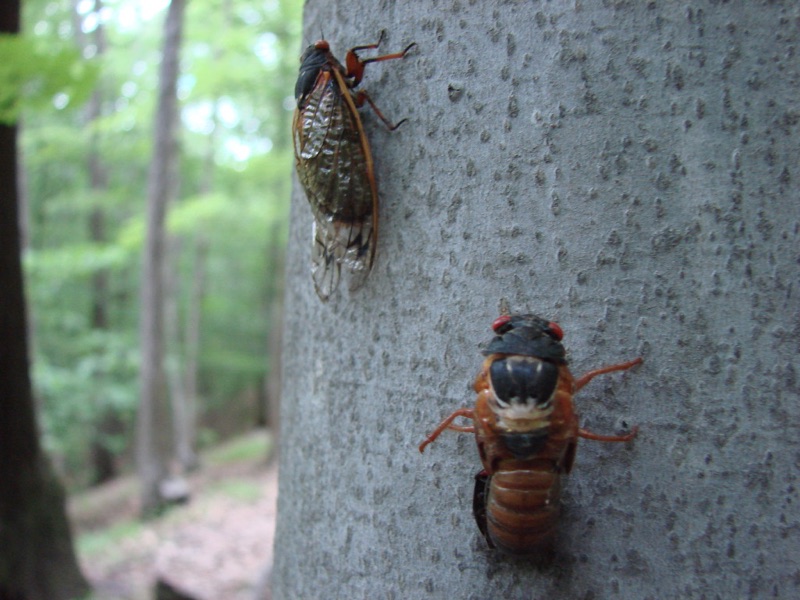
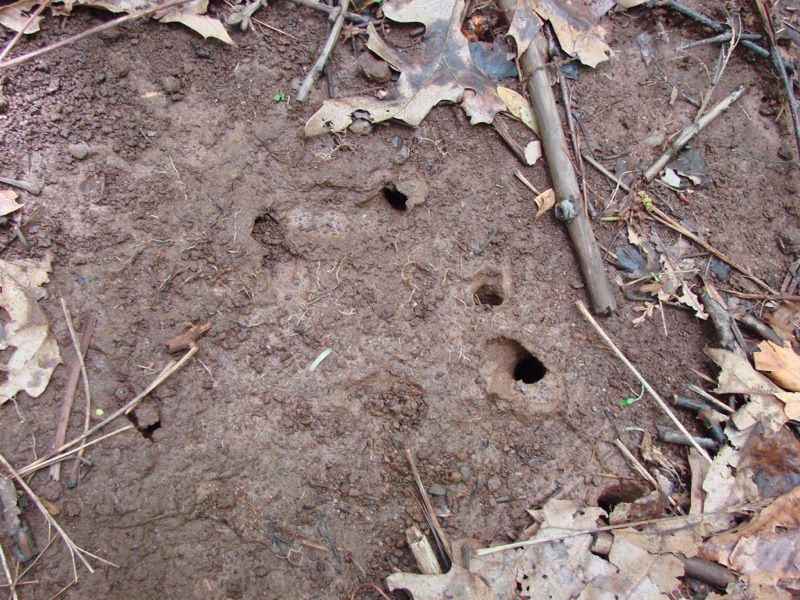
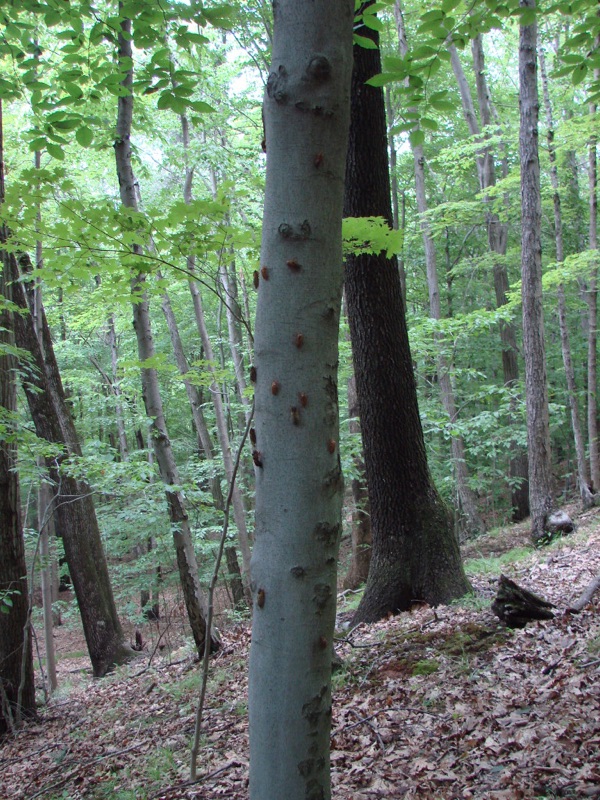
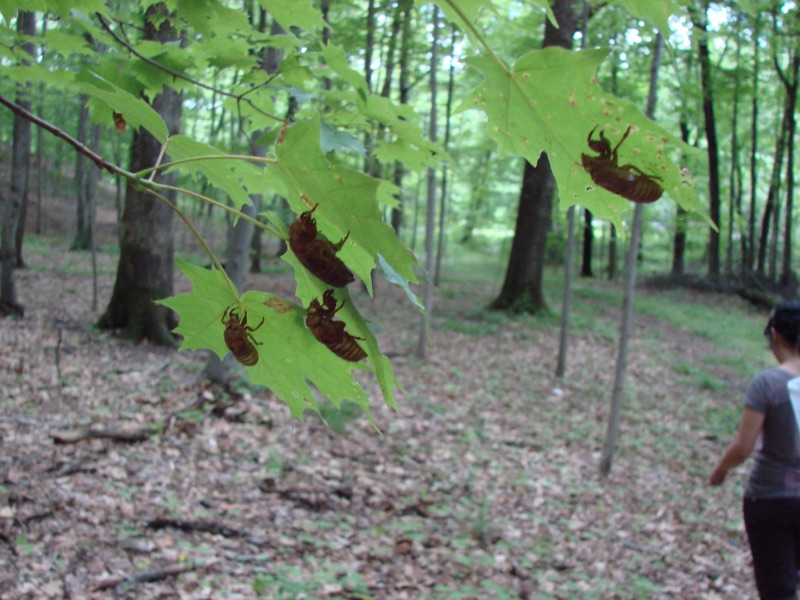
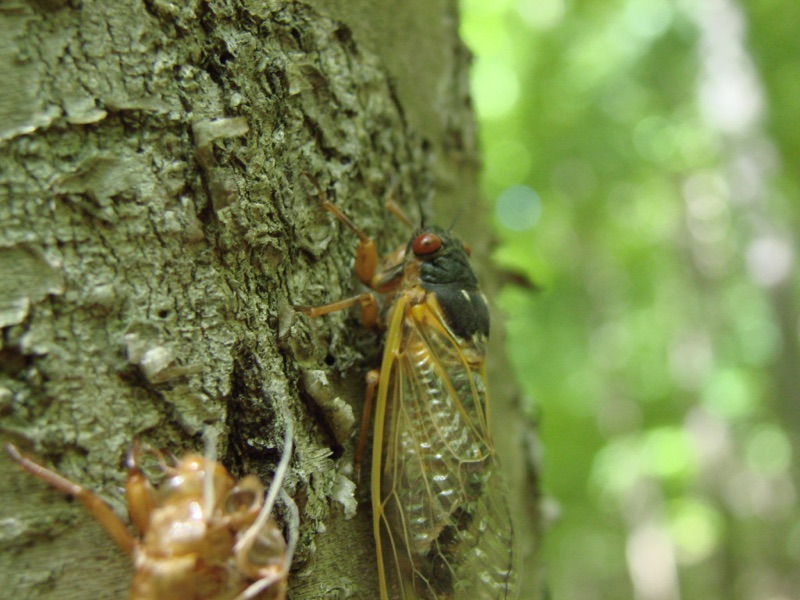
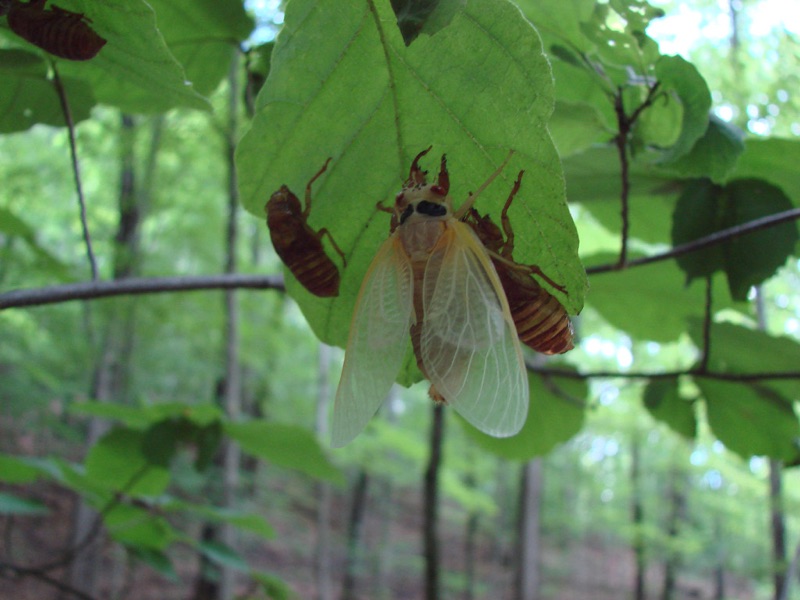
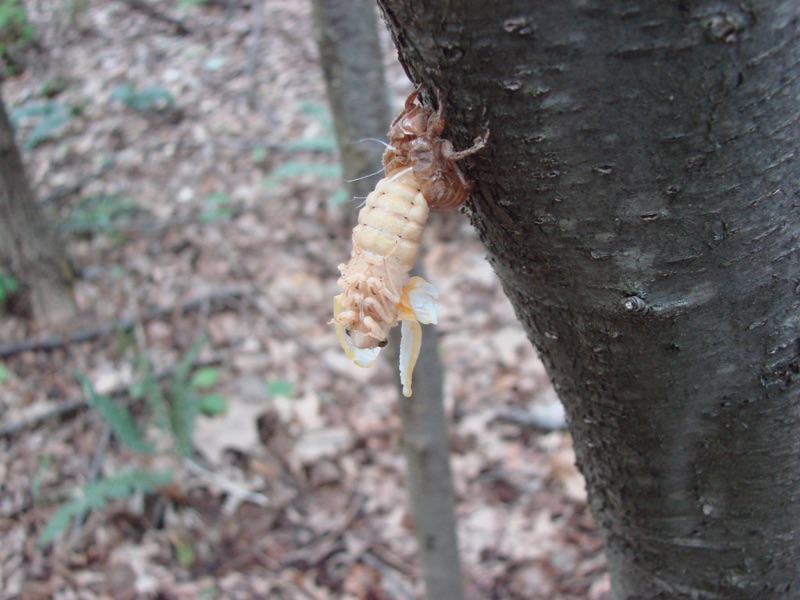
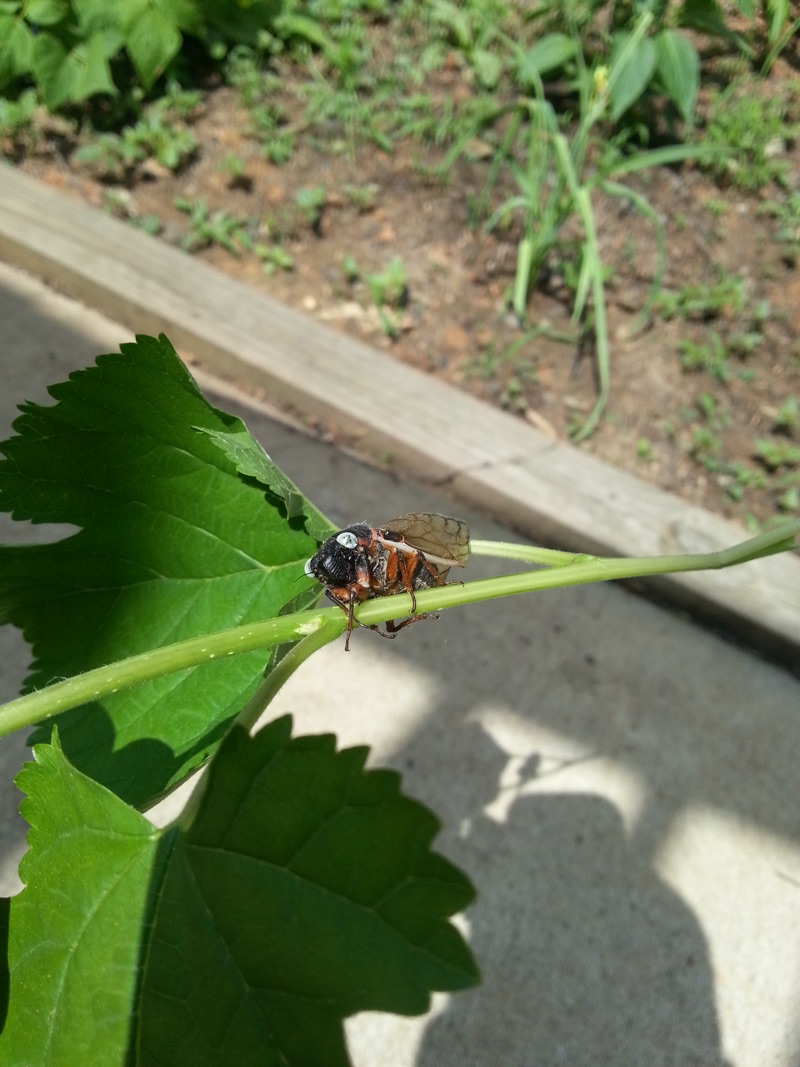
Periodical cicadas (Magicicada) are emerging in and around the Oklahoma City area, unexpectedly!

June 15th:
The Facebook page for this event posted that there are Oklahoma State University records of going back to 1996, 1979, 1962, and 1928, showing a 17 year pattern. There’s also some confusion between this “micro brood” [a term I’m using because I like beer] and Brood IV, because the Oklahoma M. cassini have orange stripes like an M. septendecula, and you can only tell them apart by their DNA (and their song, of course).
Cicadas @ UCONN had a Facebook update as well.
June 13th:
Chris Simon says they “think that this might be an undiscovered brood that just happens to coincide with Brood II.”
Gene Kristsky found a page that mentioned Brood II in OK, and Chris Simon pointed out that the cicadas fill a gap in Brood IV.
Thanks to T. Wilken for posting this image. it is a male M. cassini.
I checked the document Drew, W. A., F. L. Spangler and D. Molnar. 1974. Oklahoma Cicadidae (Homoptera). Proceedings of the Oklahoma Academy of Science. Stillwater. 54: 90-7. No specific mention of Oklahoma county.
Original post:
There is an Oklahoma 17 Year Cicada Early Emergence Facebook page. (They might be 13 year cicadas, BTW).
If you are in Oklahoma please visit Cicadas @ UCONN and report your sighting! View the sightings on the map.
Random conjecture:
- They could be Brood IV, which are due to emerge in 2015, making this a two year acceleration that brood. This could also be Brood XIX, which last emerged in 2011, making this a two year deceleration.
- They could be an undocumented emergence of Brood II.
- But the really weird thing is, Oklahoma City is outside of the Brood IV and Brood XIX areas.
- Did some windy weather move the cicadas westward?
- Did a nursery in the Brood IV or XIX area inadvertently move them to OK City?
- Did someone play cicada egg “Johnny Appleseed”?
Here’s some cicada video I shot over the weekend. Enjoy:
Magicicada trying to take a drink from Cicada Mania on Vimeo.
Singing Magicicada septendecim from Cicada Mania on Vimeo.
Magicicada septendecim ovipositing from Cicada Mania on Vimeo.
Magicicada septendecim ovipositing from Cicada Mania on Vimeo.
Close up of a tymbal of a Magicicada septendecim from Cicada Mania on Vimeo.
When Roy Troutman visited New Jersey and New York in 2013 for Brood II he took a lot of great cicada photos.
Here is a sample of the best.
Click the images for a larger version.
Visit Gallery #2 and Gallery #3 for more.
A mass of exuvia and corpses by Roy Troutman
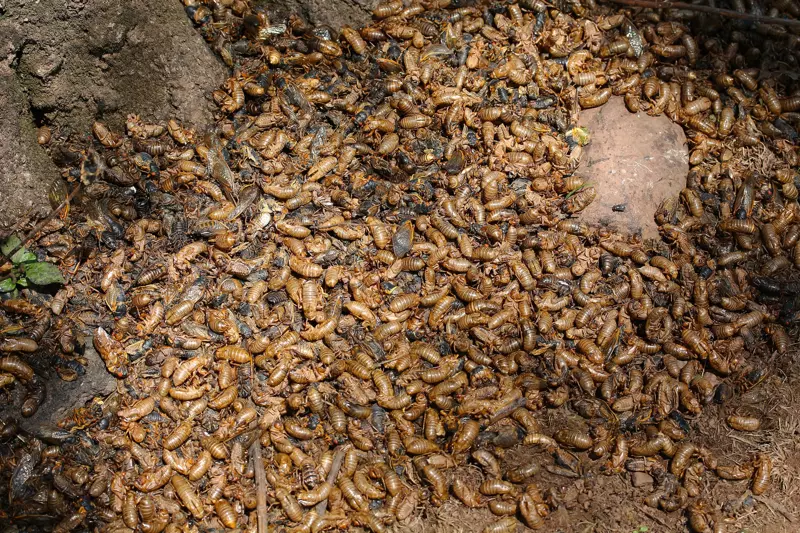
Adult Magicicada on a pine tree by Roy Troutman
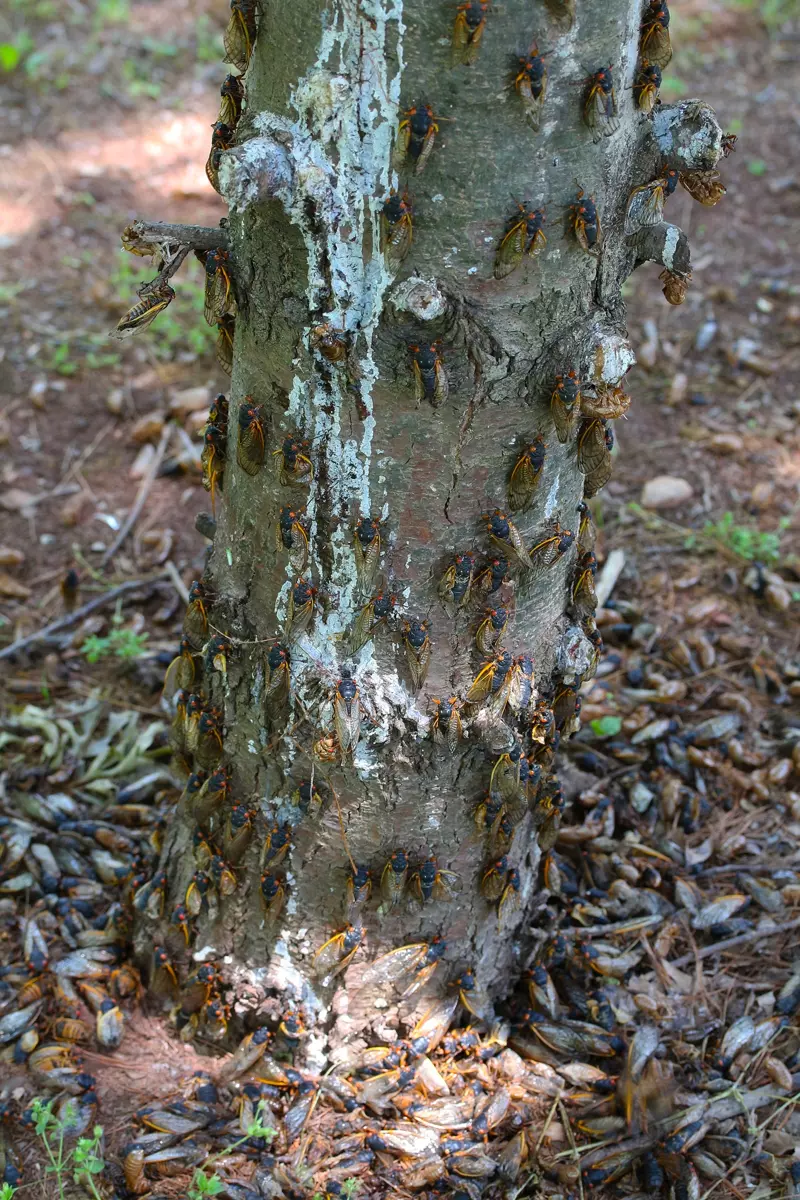
Cicada Art at the Staten Island Museum by Roy Troutman
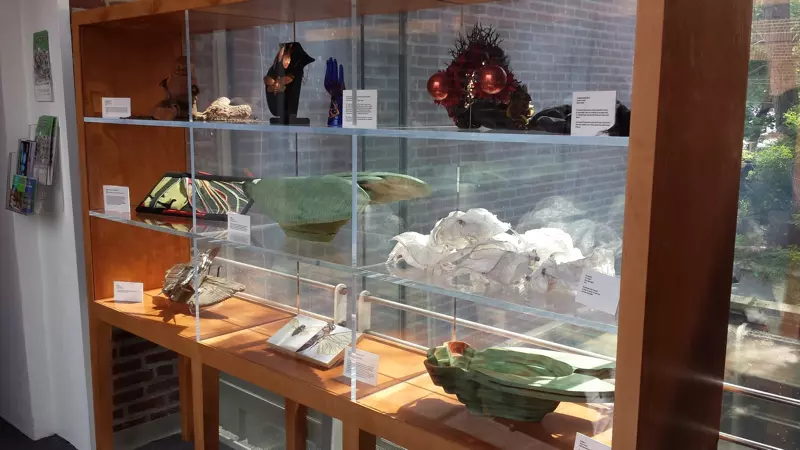
Cicada Timeline at the Staten Island Museum by Roy Troutman

Crippled Magicicada by Roy Troutman
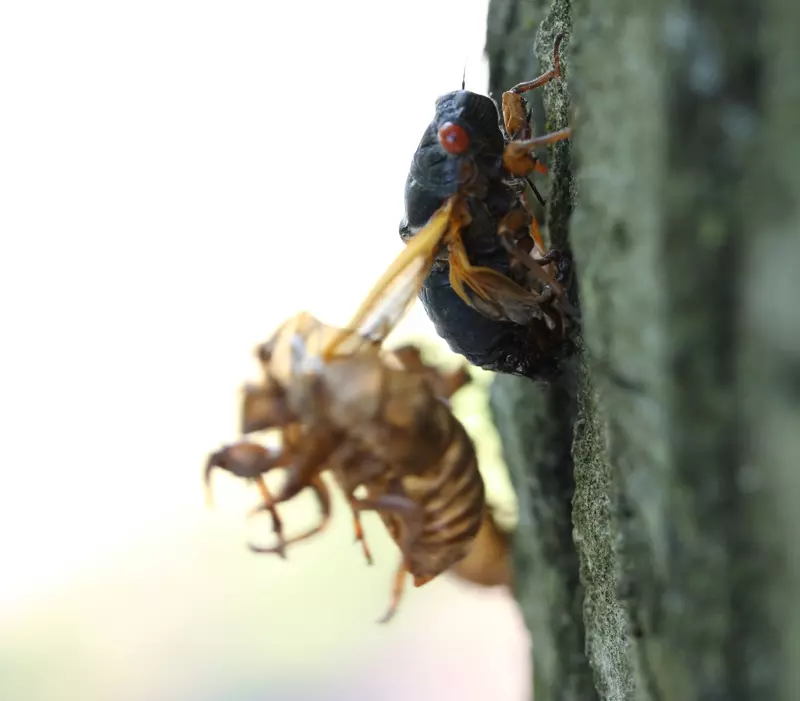
Dan Mozgai, Roy Troutman and Elias Bonaros at the Staten Island Museum by Michelle Troutman
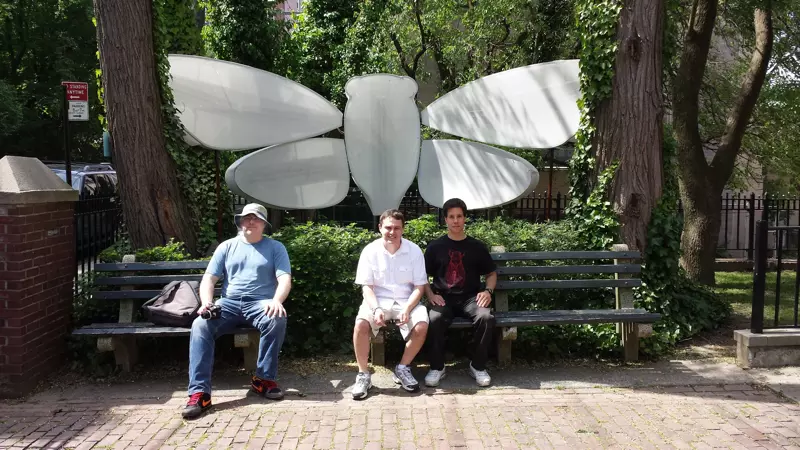
Elias Bonaros in the Manhattan Subway new a Cicada Tile Mosaic

